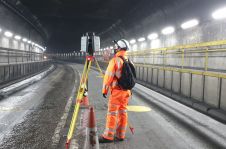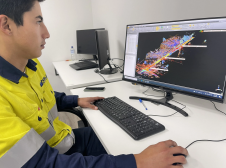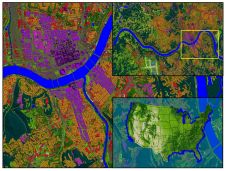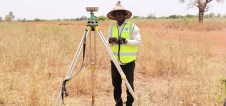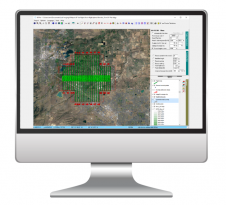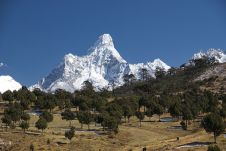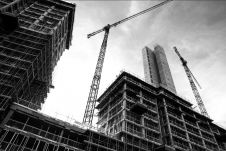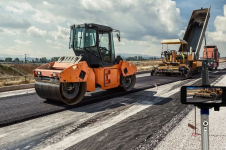Landscape Issues in Poland
Much of Poland’s rural landscape has unique cultural and aesthetic value and should be recognised as a national asset. In economic terms, however, small, scattered parcels demand thorough land consolidation, an activity that also threatens the landscape. How may land consolidation be used not only in reallocation but also to preserve the landscape? The authors propose studies to serve both aims. But, first and foremost, all parties must be made aware of the (economic) benefits of landscape preservation.
Polish rural landscape, the present farm structure of which has evolved over many centuries, is recognised as a valuable contribution to the European Union (EU). Since children have all inherited a piece of their parents' property, land plots are widely scattered. So that today, the resulting dense network of boundary strips is essential to both eco-systems and landscape. But agricultural production is greatly impeded by small and scattered parcels, resulting in an urgent economic need for land consolidation.
Landscape Architects
土地整理与dilem相关联ma: it is necessary for economic development but can also destroy the landscape. Traditionally, land consolidation in Poland has, as in many countries, been focused on improving the productivity of agricultural land. Although today ecological issues are considered, this occurs only on an intentional basis and landscape architects question the adequacy of this attitude. The debate is now how land consolidation can play a role as a tool in landscape preservation. Landscape architects are taking the lead in this debate; they are able to carry out proper studies and prepare guidelines for rural development with respect for land preservation. A number of such studies are proposed here.
Inventory and Ecology
The landscape needs first to be inventoried for natural and anthropogenic elements and structures, objects of tourist interest, topography, geology, uniqueness and tourist infrastructure. Initial fieldwork should also include preliminary valuation. The inventory should not be limited to the area of land consolidation itself, but be defined by natural landscape borders, which generally cut across administrative ones. Ecological studies will provide not only information on areas in need of landscape preservation, but also on:
-biosphere, in particular habitats of unique and disappeared species
-lithosphere, in particular terrain topography and relief
-hydrosphere, in particular water courses, erosion and sedimentation areas, wetlands, swamps, flooded areas etc.
Ecology should be studied using standard land-consolidation procedures as carried out in most European Union countries.
Attractiveness
The attractiveness of a landscape depends on the presence of spatial dominants and particular spots with special appeal for visitors. Spatial dominants rule the landscape through their dimensions or location. Examples are church and water towers, large, solitary trees, and manor houses with surrounding parks. Particular spots are small artefacts of historical or cultural value, for example chapels, shrines, crucifixes, memorial cemeteries and irregularly shaped boulders. These are usually situated at crossing points, the entrance to villages, on bridges, dykes and so on. After individual identification, their connection to these sites, both functional and visual, should be determined. Functional connection here implies how to get from one place to the other by car, bike or walking. Visual connection relates to the view structure: which spots can be seen from a certain viewpoint, stationary or moving. GIS helps to reveal the view structure and also assists in determining optimal routes, which are not necessarily the shortest, but the most rewarding in terms of appeal. Overlays of aerial images and data from the topographic database and the Land and Buildings Cadastre may provide basic geo-data for such studies. The result will be a map of view connections, view axes, viewpoints, panoramas and so on. This may serve as a reference for landscape protection, including view preservation and landscape development: design of footpaths, bridle paths and cycle tracks.
Accessibility and Use
The landscape is a boundless common commodity and the visual property of everyone passing through it. This modern approach to landscape may create a conflict between public accessibility and public and private property rights preserved by law. The issue is thus to balance landscape protection, use by landowners/tenants and accessibility for tourists. Today many plots in attractive landscapes have been fenced off and hence excluded from public access. Since in this matter Polish law is less restrictive than are other legal systems in other parts of the world, the situation here may soon escalate towards presenting a challenge. The construction of public footpaths, bridle paths, cycle tracks and the like would prevent fencing off and guarantee access. Restrictions on land use, such as crop selection to protect natural vegetation, and construction limitations to prevent spoiling of landscape views, are effective measures in preserving landscape. The possibility of restricting ownership rights to parts of the landscape showing valuable features should also be considered. Such restrictions might range from protecting public right of way to lakes and rivers or to a wooden landing stage for observing wildlife, to a permanent pathway for walking or cycling. The restrictions on use and rights should be displayed on a map, taken into consideration when preparing land consolidation and included in the guidelines for post-consolidation land management. They may contribute to the value of land plots. Depending on changes in land use and ownership rights, alternative scenarios should be developed according to the time span between consecutive land consolidations. Potential conflict of interest between parties (ecological, economic, utilitarian, cultural, aesthetic etc.) should be minimised.
Value and Costs
土地整理是基于重新分配,ccomplishing this requires assessment of the value of land plots. In the traditional approach, the main value factors include soil quality and distance from village. A new market valuation is now proposed, at least for plots with permanent crops, such as orchards. The market value of landscape components is difficult to estimate, but it is also the only parameter enabling considerations over and above restrictions on ownership rights. Who should pay the costs? In general, these parties should be the ones who benefit. Three are involved: land consolidation participants, local community and society as a whole. The costs should be spread among them: participants donating areas of land, the local community claiming local taxes, and society as a whole contributing by asking the general public to pay to visit the area for leisure purposes. The hardest is to convince land-consolidation participants that they would gain by forfeiting land. One thing is certain: by losing land they will gain, as tourists bring in money and create jobs. A rising awareness of economic reward will also convince the local community that local taxes are not a waste of money, but a source of future revenue. Such awareness will serve too to ease acceptance of limitations on land use. A catalyst for this process might be land donation by the Agency of State Rural Ownership. Traditional land communities, still existing in Poland, could also play a crucial role.
进一步的阅读
- Pulecka A., Kupidura P., GIS Supporting Landscape Issues in Land Consolidation Works in Poland, FIG Working Week 2007, Hong Kong SAR, China, 13-17 May 2007.
-Adrianna Pulecka, Warsaw University of Technology, Faculty of Geodesy and Cartography, Plac Politechniki 1, 00-661 Warsaw, Poland, email:adrp@go2.pl
Make your inbox more interesting.Add some geo.
Keep abreast of news, developments and technological advancement in the geomatics industry.
Sign up for free


